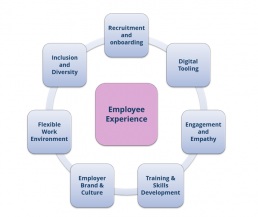The COVID-19 pandemic forced businesses and the workforce to come towards a new understanding around employee experience. The pandemic initially affected the location of work and ushered in new models for the workplace, but at its core it sparked a new conversation about the entirety of what being an “employee” is and how to best manage them; from digital tools to remote recruiting, to onboarding, and performance management, to work life balance, inclusion and diversity and mental wellbeing, all these questions are becoming essential.
Why is Employee Experience Important Today?
There has always been a strong connection between employees and business success; the received wisdom is that successful organizations are built and supported by talented and successful people. However, today more than ever, there is a relentless demand for top employees and the labour market is struggling to keep up across Europe.
In addition, the wave of resignations aka “The Great Resignation” has highlighted the impact of the pandemic on the workforce and the new challenges that this increased turnover is placing on businesses. Furthermore, the digital tooling necessary to support remote work is crucial, making the difference between those companies that are digitally adept and those that struggle with connecting their teams and sustaining their productivity.
The truth is that employee experience is becoming more far reaching, impactful and comprehensive; recruitment, onboarding, training, and development or even how to stay connected with employees, ensuring they’re still satisfied with their experience at the company is at the top of mind of every Human Resources director and their HR teams. Those companies with a well-executed employee experience strategy will have a competitive advantage over their counterparts, securing access to critical skillsets and limited employee churn.
What Makes Up Employee Experience?
In order to set about creating an effective Employee Experience strategy, one needs to understand what the components are and the key parts of it. Long gone is the era when a simple HR information system and a couple of annual appreciation and awareness events would pass as “employee experience”.
It all starts with the recruitment process which then naturally flows into onboarding. It expands to engagement and empathy, the policies and strategy behind skills development and training, all the way to the type and processes around the flexible work environment, which is becoming one of the most visible aspects of Employee Experience in our time. However, digital tooling, the policies around inclusion and diversity, as well as the overall culture and employer brand are important pillars of Employee Experience and are gaining prominence in a post COVID-19 world.
The implication here is that these pillars go beyond the HR department itself and that Employee Experience has multiple facets and various stakeholders. In addition, the challenges that emerge cannot be viewed in isolation, but rather as something that coexists in the same continuum. Everybody has a stake on this and everyone in the organisation is standing to benefit from an engaged, high performing, empathetic and balanced workforce.
What Are the Next Steps in Your Employee Experience Journey?
First and foremost, there needs to be a clear and wide internal communication about the “employee experience” vision. The answer to that vision is coming up with the answers on some basic questions. For example:
- What type of work environment are you trying to create?
- What are the requirements in terms of digital tools or perhaps real estate?
- What is the preferred model regarding work from home or the office?
- What type of structure works best for the business, e.g., a flat and fast flowing organisational chart, or more structured and process driven model? Is that structure applicable to all parts of the organisation?
- How can we use technology (e.g., workforce analytics, HCM systems, engagement measurement tools) to support this vision? Do we need more investments and how should we go about them?
The next natural step is to come up with specific targets and at least a provisional timeline for making this employee experience a reality. This will most likely require introducing new KPIs for managers and employees alike, that will focus beyond simple performance goals and will feature added focus on things like diversity, engagement, personal growth, career planning or skill development.
Following through from this step, is the introduction of regular progress report check points, not as a performance review exercise, but to determine what works best for specific teams, what are the areas where progress is being made and what areas may need retuning. No plan survives contact with reality, and businesses must accept that their employee experience journey will require adjustments and changes.
Finally, the last step is to create a set of best practices, rules, policies, and forums that will enable the business to remain agile and effective when it comes to employee experience. The vision can sometimes change for reasons beyond one’s control, the technology may improve and help uncover even more actionable insights, and the KPIs may be quickly reached, and the timeline accelerated; thus, the pursuit for an always relevant and effective employee experience should not be seen as point in time, but rather as a dynamic process.
If you want to learn more about this topic or have any questions, please contact Alex Stratis, or head over to https://www.idc.com/eu and drop your details in the form on the top right.


